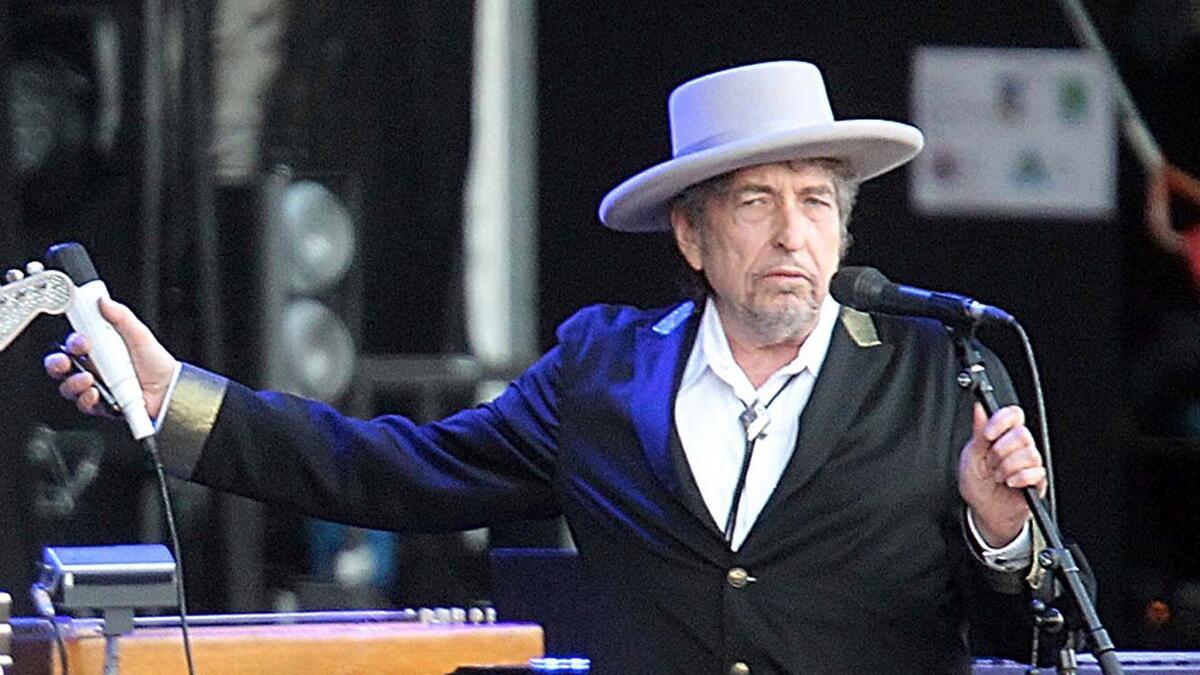Op-Ed: Why Bob Dylan’s art will survive even if the printed word doesn’t

- Share via
Bob Dylan recorded his first LP for Columbia Records 55 years ago next month. John Hammond, the legendary Columbia producer responsible for discovering Bruce Springsteen, Billie Holliday and Aretha Franklin among others, signed the adenoidal wunderkind. Just a few weeks earlier, New York Times pop music critic Robert Shelton had anointed Dylan as the next big thing. It looked like a golden lift off for the 20-year-old college dropout from Hibbing, Minn., although no one would have predicted a Nobel Prize in literature.
But Dylan’s Carnegie Hall debut, on Nov. 4, 1961, attracted only 52 people. Dylan got lost on the subway and arrived 40 minutes late. The concert promoter lost his shirt. Dylan was paid $20.
The career stumbles didn’t let up. Six months after its release, Dylan’s eponymous first LP had sold a dismal 4,200 copies. Most of the tracks were nasal covers of traditional folk songs performed far better by other up and comers like Joan Baez and the Kingston Trio. Around Columbia, Dylan came to be known as “Hammond’s Folly.”
He looked doomed until he turned it all around, a trick of fate he worked out first with pen and paper. He crafted a traditional riddle song into “Blowin’ in the Wind” and put his own lyrics to the traditional hillbilly tune “Who’s Gonna Buy Your Chickens When I’m Gone?” for “Don’t Think Twice, It’s All Right.” Beneath the careful synthesis of Dylan’s imagination, the folk standard “Down on Penny’s Farm” became the manic anti-Vietnam farce “Maggie’s Farm,” and the medieval Child ballad “Lord Randall” transformed into the apocalyptic “A Hard Rain’s a-Gonna Fall.”
As with his contemporaries the Beatles, his poetry evolved quickly and unpredictably into verse that defined the essence of the tumultuous 1960s, but unlike the Fab Four, Dylan soldiered on through the rest of the 20th century, adding more and more standards to his oeuvre with each passing decade. Dylan became a master class in American culture, and his influence persists to the present day.
Nowadays, Dylan takes his Never Ending Tour to packed venues around the globe. He has released 70-plus albums that have sold more than 100 million copies. Like it or not (he has always said he does not like it), he became the voice of a generation.
Ironically, Dylan claims to speak, write, play and perform only for himself. It just so happens what he has to say captures what millions of others believe to be true and poignant, witty and wise.
I took some heat for my 2014 Bob Dylan biography: I was too wry and too raw in taking him to task for drinking, drugs and womanizing. For a while anyway, Dylan channeled William Blake, especially the part about the road of excess leading to the palace of wisdom.
Dylan the human being has his faults, tragedies, addictions, and surely his regrets. That doesn’t disqualify him as a master storyteller. Dylan the storyteller is almost perfect. And anyway, faults and tragedies are the raw material of art.
Those who worry and whine that a self-professed song and dance man has superseded Philip Roth, Margaret Atwood and Don DeLillo in the Nobel sweepstakes ought to take a step back and get a good look at how media has evolved during the half a century since Dylan’s voice first entered the American imagination.
It’s no secret that the printed word has fallen on hard times. Even recorded music, Dylan’s primary medium, struggles to find a survivable business model. It’s the same with film and video. All media are under digital attack and the ease with which music, video, novel and film can be pilfered puts art itself in jeopardy. Would Robert Allen Zimmerman even try to become Bob Dylan in the Internet age?
I believe the answer is yes. Like all the Nobel laureates that came before him, Dylan is compelled to spin his yarns, to labor over each word and image. A single Dylan song dips into the rich loam of American tradition and evinces the sort of character, plot and mood that it took a Hemingway or a Faulkner entire novels to reveal.
Dylan’s art will survive even if print doesn’t. The world may have changed mightily since he rolled into Greenwich Village, but his words and music still touch the heart, confound the mind and lift us up. That’s testimony enough for me — and apparently for the Nobel committee — that Bob Dylan stands with the best wordsmiths of our time, and all time.
Dennis McDougal is the author of the Vietnam novel “The Candlestickmaker” and nine books of nonfiction, including “Dylan: The Biography.”
Follow the Opinion section on Twitter @latimesopinion or Facebook
A cure for the common opinion
Get thought-provoking perspectives with our weekly newsletter.
You may occasionally receive promotional content from the Los Angeles Times.






